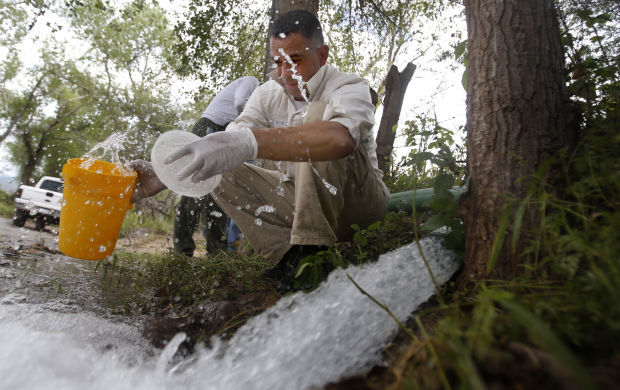Legal actions regarding one of Mexico’s worst mining spills in recent history are moving forward.
A Sonora judge recently ruled that the national water commission, Conagua, is required to measure the water quality in the more than two dozen wells along the Sonora River to ensure they are no longer contaminated, said PODER, a nonprofit that works to improve corporate transparency and accountability in Latin America.
The group is representing about 600 residents united under the front Los Comités de Cuenca del Río Sonora and filing public-information requests related to the spill and its aftermath.
Another of the legal actions filed by the group moved up to the Mexico Supreme Court last week, which has four months to decide whether to hear the case. If it does, it will be a historic move, said Benjamin Cokelet, executive director of PODER.
Under current law, a company can be sued in civil court, but the group wants to be able to file suit under an amparo, a Mexican legal proceeding that serves to guarantee constitutional rights. It argues that even though Grupo México is a private company, at the time of the spill it was acting as a government concessionaire.
Under the procedure, Cokelet said, the community would have “a much wider legal breadth of resources available to them to pursue justice.” For instance, a judge could order the company to provide long-term remediation or to pay higher penalties.
On Aug. 6, 2014, 11 million gallons of a copper-sulfate solution poured out of a containment pond at the Buenavista del Cobre mine — about 25 miles from the Arizona border — and polluted the Bacanuchi and Sonora rivers. It affected the livelihoods of more than 22,000 Sonorans. Buenavista del Cobre is a subsidiary of Grupo México, which also owns the Asarco mining company.
Contaminated water, created by the mining company spraying sulfuric acid over piles of crushed ore, was sent to a holding pond that breached, experts have said. The solution was highly acidic and carried high concentrations of toxic metals such as cadmium, copper and zinc, which in high concentrations can be harmful to humans and aquatic life. The predominant metals in both cases were the relatively less toxic aluminum and iron.
Grupo México paid $1.4 million for using installations that weren’t finished and for not having the required operating permits, in violation of several federal laws, Arturo Rodríguez Abitia, deputy director for industrial inspection at Mexico’s Federal Department of Environmental Protection, Profepa, told the Arizona Daily Star in October 2014.
Because the project was under construction, there were no overflow ponds or impermeable linings to contain the liquid. A valve that could have stopped the spill hadn’t been installed.
Initially, the company said heavy rains led to the discharge, but later acknowledged it was due to faulty pipe seals in the Tinajas 1 system, part of the construction site of a new copper-processing plant. It took 25 hours after the initial discovery to notify authorities — and two hours beyond that to contain the spill. The company built a barrier to stop the discharge and used lime to neutralize the acidity.
The federal government imposed 30 corrective technical measures, Profepa officials told the Star. Grupo México has complied with 21 and asked for an extension on the rest.
So far, Buenavista del Cobre has finished construction of sediment ponds and contingency systems meant to prevent another spill, Profepa said. It is also building geomembranes and waterproof screens around the tanks to guarantee that the subsoil won’t be contaminated.
The company also created a $125 million fund to compensate residents for their losses and for remediation. But not all the funds have been distributed, and the process has been contentious. Accusations of corruption and misuse of funds are rampant.
Even though federal officials have said the water is safe to consume and reopened most wells, residents have little trust and continue to purchase water when possible, residents have said. Cokelet noted reports of well water with a yellow color and bad odor. Others have presented skin rashes that look like bruising, Banámichi residents said.
Repeated requests for comment to Conagua were not returned.
Last week, Lacy Tamayo, deputy secretary for environmental policy and planning, was quoted by the radio station Uniradio as saying the Secretariat for the Environment and Natural Resources has sought the assistance of Mexico’s Autonomous University, the University of Sonora and the University of Arizona for additional water testing.
Top company officials have been quoted by local Mexican media as saying the river has been remediated, but out of five zones, only one has been completed, about 19 miles from the spill and within the private boundaries of the mine.
PODER has filed more than 120 freedom of information requests, Cokelet said, to understand the technical causes behind the spill, any negligence before the spill and steps that have been taken since. In thousands of documents that have been turned over to the group so far, he said, they’ve found that the company incurred more than 55 irregularities before the spill, including the lack of an environmental impact study and a toxic-remediation plan, missed filings and cut corners.
PODER and the river committees have also taken legal action to ensure that mining companies are more respectful of the environment and that the Mexican government alter the nation’s drinking-water standards to be more in line with those in countries such as the United States. For instance, the allowed level for arsenic is 2.5 times higher than in the United States.





